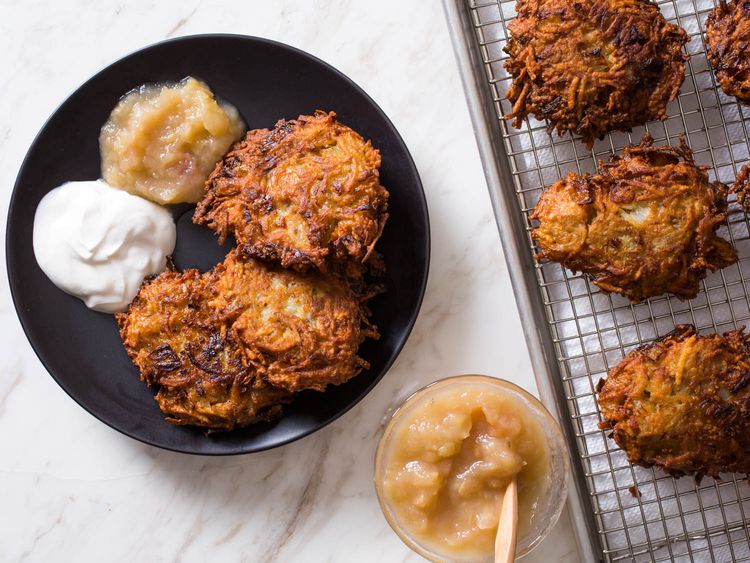Old-Fashioned Latkes

- Serves: 16 latkes
- Time: 60 min
- Date added: 2025-01-05
Description
Crisp, plump, and potato-y, with wispy, lacy edges, these old-fashioned latkes need no gussying up.
A lot of the problems in latke-craft stem from a misunderstanding of what a latke is. To start, it's not a potato pancake. Potato pancakes have a creamy, almost mashed-potato-like center, with a thin, golden, crisp exterior. Latkes, on the other hand, should have a deeply browned crust, with wispy, lacy edges.
Latkes also aren't hash browns. Hash browns are all about crispy, burnished crust, with just enough potato-y center to gain a third dimension and a little give. A latke's interior should be plump and slightly cakey, but yielding, with recognizably rustic strands of potato intertwined with onion.
To put it in burger terms, a latke should combine a pub burger's heft with a smash burger's crust—the best of all possible potato worlds.
I'm going to ask that you bear with me on this definition. If you prefer your latkes extra thin and crispy or with creamy centers, try these and see if they change your mind. If they don't, I'm not going to say that what you've lovingly made for your family isn't a latke, but we're going to have to agree to disagree.
Why It Works
- A food processor creates large, firm shreds of potatoes, making a heftier latke with nice lacy edges.
- An ingenious trick for squeezing out excess moisture from the shredded potatoes (combined with incorporating the released starch back into the potatoes) helps produce extra-crisp latkes.
- Frying in a cast iron pan results in a deeper, more burnished crust, and requires less adjustment of the flame due to cast iron's superior heat retention.
Ingredients
- 4.5 pounds (2kg) russet potatoes (about 7 medium-large)
- 5 cups diced onion
- 4 large eggs
- 1.25 cups matzo meal (more or less as needed)
- 2 tablespoons (24g) kosher salt, to taste
- Canola or peanut oil, for frying
- Applesauce and sour cream, for serving
Directions
- Shred potatoes with the grating disk of a food processor. After every 2 or 3 potatoes, wrap shreds in cheesecloth that has been folded over twice. Tie corners around the handle of a wooden spoon and twist bundle until water flows out. Collect water in a bowl and squeeze all potatoes until dry. Transfer potatoes to a large mixing bowl along with diced onion.
- Let drained potato water sit, undisturbed, until a pool of brown water forms on top of a slurry of pale potato starch. Carefully drain off water, then mix starch into potato and onion mixture with your hands. Mix in eggs, one at a time, alternating with 1/4-cup additions of matzo meal, until latke mix can be formed into patties that just stick together in your hands. Add salt incrementally.
- Heat 1/2 inch oil in a cast iron skillet over medium-high heat until a shred of potato immediately bubbles when added to pan. Form a small amount of latke mix into a disk and fry on both sides until golden brown to test for seasoning. Taste and add more salt as needed.
- Form latke mix into patties about 4 inches wide and 1 inch thick in the center. Slide into pan, cooking no more than four at a time. Fry until a golden-brown crust forms on bottom, then flip with a slotted spatula and fork until same color is achieved on other side. Flip as needed to get a firm, darker-than-golden crust on both sides.
- Transfer to a sheet pan lined with paper towels to cool for 2 minutes, then serve with applesauce and sour cream at the table.
Notes
These ingredient amounts aren't law; depending on the moisture content of your potatoes, you may need more or less binder, or a different balance of eggs and matzo meal. What's important is that the latke patties don't fall apart in your hands, or they certainly will in the pan. Start with a little egg and matzo meal, then add only as much as you need.